Space Options - Residential Design
Menu

Our residential design services focus around renovating existing homes. We are known for home renovations that provide greater independence, safety, and comfort for seniors and those with disabilities. We achieve this by removing obstacles and making spaces and components more functional as well as improving aesthetics. Changes are customized to fit your current, specific needs but also with an eye toward the future to sustain ‘aging in place’. Most existing homes were not originally designed with an understanding that our degree of mobility, strength, balance, and other abilities can vary in the course of our lives, whether due to disability, chronic health problems, or aging. We help overcome residential design limitations.
We offer options for home renovations that suit you as an individual. Since the goal is to adapt your home to fit your needs and preferences, we first discuss what helps you now in your home and what does not. Next we do a methodical review of your home’s functionality with you, considering ideas and solutions together. If we notice problems that you may not have considered, we mention those, thus limiting unnecessary future renovations. Then we go over the list and you decide your priorities. We prepare a firm work authorization so we agree on the scope of the work and costs, and we don’t exceed that unless you ask us to expand the work.
Making a home accessible requires knowledge, skill, and experience. Improvements should be designed to serve all who share your home and your visitors, with a goal of meeting your immediate and future physical needs. Every change being considered must be compatible with existing structures and land topography and be cost effective. We also consider state and county building codes that may impact your options. And, of course, planned modifications should blend well with your own unique style and preferences and with the aesthetic of your existing home.
Our thanks to Charlotte Townsend, Theo Sheen, and Beth Arnoult for demonstrating access possibilities below.
Entry Way Access – Ready access between your home and the community boosts your safety, security, and independence. Ramps, stair lifts, handrails, curb cuts, and sidewalks are the basic elements to make an entry way accessible.
But careful design of these elements can affect your satisfaction with the changes. With knowledgeable design, the final built product will be be safe, easy to use, aesthetic, easy to maintain, and able to serve multiple functions. Improvements can be beneficial for many uses and many users.
Ramps, as shown in these two photos on the immediate right, are an example of the multi-function design concept. When ramps replace stairs, people with walkers, carts, baby strollers, bikes, and rolling luggage can all appreciate the convenience.
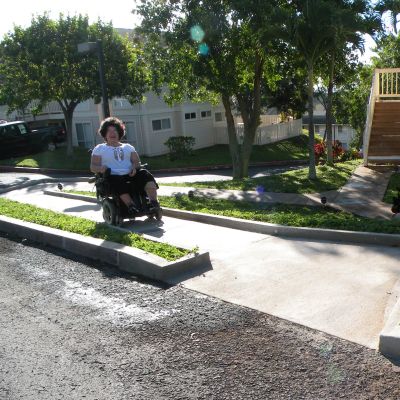
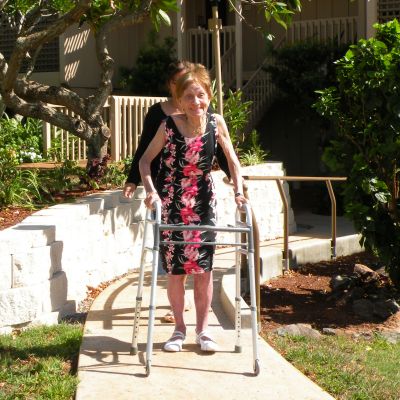
Living Spaces – Homes can be made accessible with attention to open spaces, door width, door hardware, thresholds, flooring, lighting, step removal, and type of furniture and arrangement.
This elegant kitchen table in the photo on the right has a single pedestal leg, thus allowing leg room for a wheelchair. The hardwood floors are easy to maintain, take less physical force for wheelchair movement, and avoid the tripping hazards of carpets.
In the home office shown on the far right, the open U-shaped design allows free access to all areas of the space. The desk is designed so office materials and files are readily accessible at a convenient level to anyone using the space. The open architecture of the walls and use of windows gives both a spacious feel and makes it easy to maintain contact within the home.
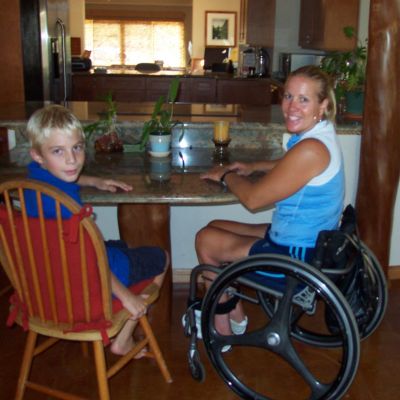
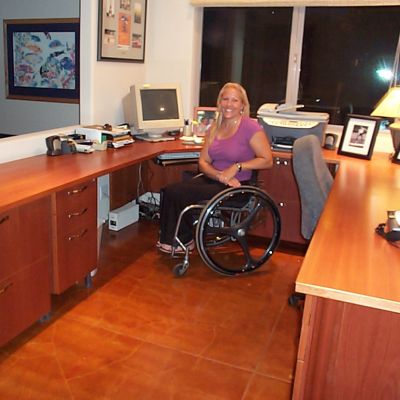
Kitchens – A kitchen can benefit from renovations. Glass stove tops and wider sinks with space under them, special refrigerators, pull out cabinet drawers and shelves, and lower height counter tops can all make kitchen work easier. These changes can be helpful for anyone with chronic health issues who finds is safer or more comforatble to sit to prepare food in a kitchen rather than stand.
Correctly modified kitchen drawers can require only minimal force to pull out, yet be designed to safely bear the weight of kitchen items.
This double drawer dishwasher allows for easy reach and is economical, since the drawers can function independently for small or large loads. There are many models of ADA-compliant dishwashers now manufactured for the home.
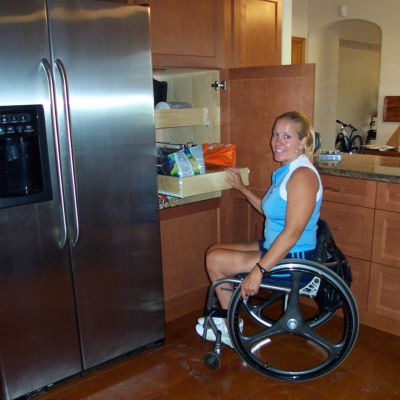
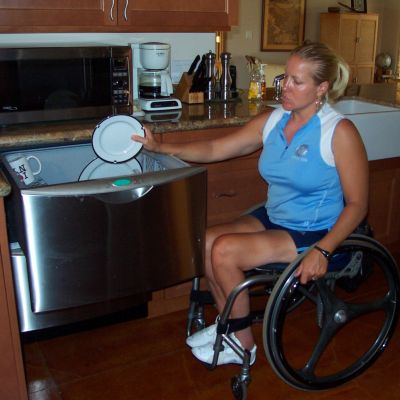
Bathrooms – About 235,000 people visit emergency rooms each year due to injuries suffered in the bathroom. The most hazardous activities for all ages are bathing, with use of the toilet a high risk for seniors. Grab bars, non-slip shower strips, flooring, lighting, and ADA height toilets can all increase safety, while maintaining an attractive decor.
A key element for safety is reducing tripping hazards and and providing sufficient space. One safety enhancement is to eliminate the typical transition step between the bathroom floor and shower or tub. The photo shows that the transition barrier has been eliminated. Glass block walls provide visual privacy.
Bathroom sinks can extend beyond the cabinetry and have room underneath to allow easy wheelchair access. This allows for much greater independence in daily activities.
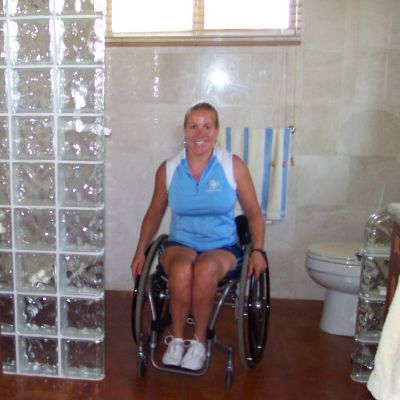
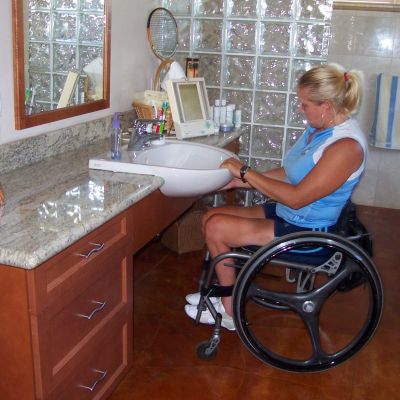
Outdoors – Being able to enjoy the outdoors in Hawaii is a large part of enjoying your home. There are many options that allow seniors to be active in the yard, such as installing raised garden beds, irrigation systems, and adding sun and rain protection features.
Smooth driveway transitions with ADA recommended slopes makes the outdoors inviting for everyone. The wide driveway makes it easier to maneuver in and out of vehicles, and also improves the ease of maintaining the area. The slope is designed to remove excess water quickly, thus reducing slipping hazards.
The smooth walkways around the house give good access to all areas of the property and allow multiple entry and exit doors to and from your home, both for your convenience and safety.
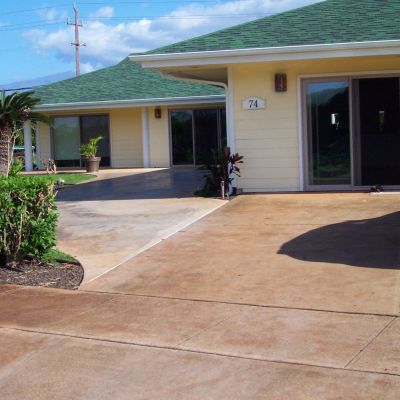
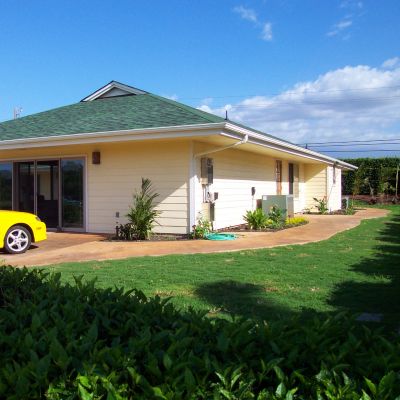
Copyright © 2025 Space Options Inc -- 808 298-3802 (cell) -- 808 878-8386 (voice) -- 808 878-8376 (fax)